129
Views & Citations10
Likes & Shares
The main objective of the study is to examine role of entrepreneurial alertness and entrepreneurial opportunity recognition on entrepreneurial intention among final year students of selected institutions in Plateau State. The study makes used of cross-sectional study. A questionnaire was adapted and administered to217 respondents of which 206 respondents filled the questionnaire and the response rate was (95%) which was used for data analysis. Simple random sampling was used and the data collected were analyzed using PLS-SEM and SMART PLS application software v.4.0. The study revealed that entrepreneurial alertness had no significant effect on entrepreneurial intention, the study also revealed that entrepreneurial alertness had a significant effect on entrepreneurial opportunity recognition. The study further revealed that entrepreneurial opportunity recognition had a significant effect on entrepreneurial intention. More so, the study showed that entrepreneurial opportunity recognition had a significant effect entrepreneurial alertness and entrepreneurial intention. The findings of this study the findings of this study came to conclusion that entrepreneurial alertness does not lead to increase in entrepreneurial intention. The findings of this study concluded that entrepreneurial alertness led to increase in entrepreneurial opportunity recognition. The findings of the study further concluded that entrepreneurial opportunity recognition led to increase in entrepreneurial intention. Moreso, the study concluded that entrepreneurial opportunity recognition mediated the relationship between entrepreneurial alertness and entrepreneurial intention. Management of University Bokkos and Polytechnic should add entrepreneurial self-efficacy to their various entrepreneurial programs encompassing design-thinking workshops, pitch-meeting simulations, elevator talks, creativity workshops, and brain-storming. Management of University Bokkos and Polytechnic should have the ability to generate good ideas and change it into an entrepreneurial concept or to enhance an existing venture that contributes to customer/societal value and produces entrepreneurial revenues. Management of University Bokkos and Polytechnic should be entrepreneurially alert and to have greater capability to recognize possible opportunities for profit than others.
Keyword: Entrepreneurial, Opportunity recognition, Alertness, IntentionSustaining an organization in a global economy filled with imitators who have a ready supply of skilled, highly motivated labor and increasing access to fund; managers must be ready to take risk towards new unproven product design and product process (Maine, S. & Dosantos, 2015). People with entrepreneurial intention tend to adopt a rational behavior to create a new business (Fatoki, 2010). generating predisposition as the foundation for the creation of new companies. Arbuthnott, (2008) expatriates the strong effect of intention to behavior as “the more personal and specific our intentions are, the more likely they are to influence our behavior”. In this regard, entrepreneurial intention can be determine based on the degree of willingness and ability of individual or group of persons to set up business in future.
Entrepreneurial intention is a desire doing productive activities effectively that directing individuals to utilize and implement relevant concepts of new business (Krueger, Reilly & Carsrud, 2000). Students’ awareness is able to be influenced and developed by external factors in terms of entrepreneurship education that underlie the emergence of their entrepreneurial intentions. Entrepreneurial intention is defined as the growing conscious State of mind and broader personal orientations, dispositions, desires or interests that drive a person to start a new enterprise or create a new core value in an existing organization (Khuong & Huu, 2016).
In Nigeria, structures and programme such as the Small and Medium Enterprises Development Agency (SMEDAN), N-Power programme, Government Enterprise and Empowerment Programme (GEEP) and the You-win programme were designed to promote entrepreneurial activities by facilitating access to funds and other resources needed for SMEs (Oliyide, 2012; Today.ng, 2018). All these policies and much more are targeted towards promoting entrepreneurship. Both entrepreneurial alertness and intentions highlights the role of the underlying entrepreneurial competencies that enable a person to scan and search for new information, connect previously disparate information, and evaluate opportunities (Tang, Kacmar & Busenitz, 2012) and also, to develop a strong motivation (Via self-efficacy beliefs and relevant mastery experiences) to engage in entrepreneurial behavior on one’s own account (Obschonka, Silbereisen & Schmitt-Rodermund, 2010). Entrepreneurial alertness can generally be seen as a highly relevant career construct in the general population, as today “alertness to opportunities is an important component of career development” (Uy, Chan, Sam, Ho & Chernyshenko, 2015).
Entrepreneur that is more alert tend to see opportunities and utilized information differently. In the face of globalized social and economic change, one of the most crucial challenges facing young persons in their vocational development is preparing for a boundary less, self-directed constructed career, in which career adaptability and a boundary less mindset are key requisites (Savickas & Porfeli, 2012). If potential entrepreneur believes that the opportunity has profit potential, then he or she may assess their readiness to stand for the uncertainties to decide whether or not exploit the opportunity by taking entrepreneurial action. Here the process of decision making does not necessitate the actual initiation or capitalizing on the opportunity, but it is his or her intentions to do it. Interestingly, a recent study examining university students in Singapore showed that entrepreneurial alertness is a strong and robust predictor of just such a boundaryless mindset and career adaptabilities (Uy, 2015). Alertness entails not only being sensitive to information or changes in the environment, but entrepreneurially alert individuals are also able to adjust their initial evaluations as a result of the social context (Urban & Gaffurini, 2017).
This study introduces entrepreneurial opportunity recognition as mediator or intervening variable in the relationship between entrepreneurship alertness and entrepreneurial intention because of consistency in previous finding. Despite its potential, entrepreneurial alertness remains understudied due to measurement problems and limited understanding of its interplay with the environmental context (Edelman & Yli-Renko, 2010; McCaffrey, 2013; Tang et al., 2012). Empirical research on institutions and entrepreneurship in emerging markets and Africa in general, has not yet paid enough attention to how entrepreneurs can best recognize and evaluate opportunities available to them when scanning their unique environments (Welter & Smallbone, 2011). According to Baron, (2007) despite opportunity recognition being seen as central to entrepreneurship, minimal efforts have been taken to examine it as a process thus ignoring the question of how opportunity recognition occurs. This also fails to address the question of the differences in the entrepreneur’s ability to recognize specific opportunities.
Despite the numerous contributions in the literature on entrepreneurship, several authors point out that the discussion about the internal factors with the greatest impact on entrepreneurial intention is still open. Several studies demand this gap be filled (Arias, Restrepo & Restrepo, 2015). Furthermore, the mechanisms that link these individual factors to greater entrepreneurial intention are still not fully understood (Barba-Sánchez & Atienza-Sahuquillo, 2017). There is a gap, then, that encourages us to delve into how acquired and perceived skills of business undertaking can connect the personal traits of individuals with their entrepreneurial intention (Mueller, 2011).
The researcher is motivated by low entrepreneurial intention of students due to several factors such as self-efficacy. Bandura & Wood, (1989) suggest that those who lack self-efficacy “concentrate on their own deficiencies, and become so preoccupied that they can’t devote the necessary attention and skill to the task at hand” and self-limiting behavior may occur when an individual has low “mastery expectations,” or self-efficacy regarding their skill and ability associated with a particular task or topic (Veigal, 1991). As Nigeria yearns for economic growth, emphasis must be laid on entrepreneurship. Some entrepreneurial programs already embarked upon by the Federal Government of Nigeria include: Youth with Innovation (YOUWIN) 2011, Family Economic Advancement Program (FEAP), Peoples Bank of Nigeria, National Economic Empowerment and Development Strategy (NEEDS), Small and Medium Enterprises Development Agency (SMEDAN), Small and Medium Industries Equity Investment Scheme (SMIEIS) ), ITF has also trained Students in ITF/FEAP, ITF/Universities and ITF/NAPEP joint ventures, these are all targeted towards promoting a vibrant entrepreneurial class that will actively articulate the economic development process. All over the world both in developed and developing economies, entrepreneurship is increasingly seen as a vital part of economic and social growth (Brancu, Guðmundsdóttir, Gligor, & Munteanu, 2015).
However, the contribution of entrepreneurship to the GDP is still unimpressive compared with other developed and emerging economies and one of the biggest challenges for entrepreneurship is a comparatively low intention and a high fear of starting a business. Despite the obvious importance and need for entrepreneurship, there seem to be apathy among students in starting new ventures with majority of them not starting one before securing white collar jobs. Fear of failure is recognised as one of the barriers to pursue entrepreneurship (Luthje & Franke, 2003 cited in Puriwat & Tripopsakul, 2015). According to Rahmi, Yusuf,Dan Priyatama, (2014) self-efficacy is needed to encourage employees to believe in their ability to achieve the objectives or expected results. It can be concluded that self-efficacy can foster entrepreneurial intentions. There is evidence of the insufficient entrepreneurial activities for the economic development among students and hence, seriously needs to be addressed. This would possibly be achieved through looking into the factors holding youth back moving toward self-employment. However, there is research intend to examine the mediating role of entrepreneurial opportunity recognition on the relationship between entrepreneurial alertness and entrepreneurial intention among final year students of Plateau State Polytechnic, Barkin Ladi.
RESEARCH QUESTIONS
Based on the Statement of the problem, the following research questions will be addressed:
- What is the relationship between entrepreneurial alertness and entrepreneurial intention Plateau State University Bokkos and Polytechnic students?
- What is the relationship between entrepreneurial alertness and entrepreneurial opportunity recognition Plateau State University Bokkos and Polytechnic students?
- What is the relationship between entrepreneurial opportunity recognition and entrepreneurial intention Plateau State University Bokkos and Polytechnic students?
- To what extent does entrepreneurial opportunity recognition mediate the relationship between entrepreneurial alertness and entrepreneurial intention in Plateau State University Bokkos and Polytechnic students?
OBJECTIVES OF THE STUDY
The main objective of the study is to examine the role of entrepreneurial alertness and entrepreneurial opportunity recognition on entrepreneurial intention among final year students of selected institutions in Plateau State. The specific objectives will include the following;
- To examine the relationship between entrepreneurial alertness and entrepreneurial intention among Plateau State University Bokkos and Polytechnic students.
- To examine the relationship between entrepreneurial alertness and entrepreneurial opportunity recognition among Plateau State University Bokkos and Polytechnic students.
- To examine the relationship between entrepreneurial opportunity recognition and entrepreneurial intention among Plateau State Polytechnic Students.
- To examine the extent to which entrepreneurial opportunity recognition mediate the relationship between entrepreneurial alertness and entrepreneurial intention among Plateau State University Bokkos and Polytechnic students.
RESEARCH HYPOTHESES
Based on the research problem, the following hypotheses are formulated for this study and is Stated in non-directional or null form (two-tailed test) as follows:
- HO1: There is no significant relationship between entrepreneurial alertness and entrepreneurial intention in Plateau State University Bokkos and Polytechnic students.
- HO2: There is no significant relationship between entrepreneurial alertness and entrepreneurial opportunity recognition in Plateau State University Bokkos and Polytechnic students.
- HO3: There is no significant relationship between entrepreneurial opportunity recognition and entrepreneurial intention in Plateau State University Bokkos and Polytechnic students.
- HO4: Entrepreneurial opportunity recognition does not mediate the relationship between entrepreneurial alertness and entrepreneurial intention in Plateau State University Bokkos and Polytechnic students.
LITERATURE REVIEW
Entrepreneurial Intention
Some extant studies show that role models affect entrepreneurial intention when combined with positive attitudes and entrepreneurial self-efficacy (Nowiński & Haddoud, 2019). Of note, this study has one important and novel finding: role models only have a slight direct impact on entrepreneurial intention but fail to have an indirect effect on entrepreneurial intention through entrepreneurial self-efficacy. Recent research on entrepreneurial education indicates that to enhance and develop entrepreneurial intention, it is recommended that entrepreneurial self-efficacy be added to various entrepreneurial programs encompassing design-thinking workshops, pitch-meeting simulations, elevator talks, creativity workshops, and brain-storming (Huq & Gilbert, 2017). In the context of entrepreneurship, intention (EI) can be defined as a “self-acknowledged conviction” by any individual that he/she is willing to initiate new business enterprise, and he/she continuously plans to accomplish this in future (Ridha & Wahyu, 2017). The EI is considered as first step toward initiating new business (Kautonen, Van Gelderen & Tornikoski, 2013). Kolvereid & Isaksen, (2006) claim that intentions are the single best predictor of most planned behavior, including entrepreneurial behavior. Pillis and Reardon (2007) define entrepreneurial intention “the intention to start a new business.” The decision to become an entrepreneur and create a new business is a deliberate and conscious decision (Wilson, Kickul & Marlino, 2007) that requires time, considerable planning and a high degree of cognitive processing. Thus, an entrepreneurial career decision can be considered as a planned behavior that can be explained by intention models. In order to understand the entrepreneurship phenomenon, studying individuals’ entrepreneurial intentions based on socio-cognitive models has been a suitable approach to analyze new venture creation (Zhao, Hills & Seibert, 2005). Ajzen, (2005) claims that people develop attitudes based on the beliefs they hold about the consequences of performing the behavior. Such consequences include both intrinsic and extrinsic rewards as financial rewards, independence/autonomy, personal rewards and family security, all of which do influence favorably the intention to start a business (Vanevenhoven & Liguori, 2013).
Entrepreneurial Opportunity Recognition
Entrepreneurial opportunities recognition (EOR) is defined by Shane and Venkataraman (2000) as the situations wherein novel goods, services, raw materials, markets and methods of organization can be launched and sold at a price that is higher compared to their production cost (Shane & Venkataraman, 2000). Along a similar line of definition, Lumpkin and Lichtenstein, (2005) described EOR as the ability to determine a good idea and change it into an entrepreneurial concept or to enhance an existing venture that contributes to customer/societal value and produces entrepreneurial revenues (Lumpkin & Lichtenstein, 2005). Meanwhile, according to Saemundsson & Holmen, (2011) explained that an opportunity is discovered when a conjecture is developed concerning the distinction between the current and future resource value. According to Baron, (2007) once an opportunity is identified the activities which an entrepreneur gets involved in at the early stages of the venture are; coming up with ideas for the new products or services, identifying business opportunities linked to these ideas, and acquiring the resources needed for growing the idea. Berglund, (2007) observes that once an opportunity has been identified and judged valuable, then the entrepreneur begins to take appropriate activities to exploit it. Similarly, according to Wood &Pearson, (2010) people with a richer source of information have a higher ability to exploit the opportunity.
Entrepreneurial Alertness
A contention is that entrepreneurial alertness reflects entrepreneurs’ ability to recognize an opportunity ahead of others (Tang, Kacmar & Busenitz, 2012). A major point of convergence is that alert entrepreneurs have greater capability to recognize possible opportunities for profit than others (Tang et al., 2012). Tang et al., (2012, p. 87) draw insights from the organizational innovation literature to contend that “alert entrepreneurs are likely to discover something new, and to increase innovations of their firms”. Entrepreneurial alertness as a cognitive resource that an entrepreneur may possess and that affords the entrepreneur a cognitive capacity to spot opportunities ahead of others (Helfat & Peteraf, 2015; Messersmith & Wales, 2013). An analytical review of the literature suggests that entrepreneurial alertness is challenging, and is related to decision-making in contexts which may be characterized as dynamic and uncertain (Urban, 2017; Valliere, 2013).
In a similar vein, Tang, (2012) report that entrepreneurial alertness entails not only being sensitive to information or changes in the environment, which indicate the possible existence of an opportunity but entrepreneurial alert individuals are also able to adjust or reconsider their initial evaluations as a result of environmental cues. For instance, recent research highlights that cultural dimensions have an impact on the managerial and strategic choices of an entrepreneur and force him to adapt to his environment (Guilluy-Sulikashvilia, 2018). Research acknowledges that although most individuals scan their environment, successful entrepreneurs may be better at discovering opportunities embedded in that environment as their alertness allows them to spot high-potential opportunities (Alvarez, Barney & Anderson, 2013).
Furthermore, entrepreneurial alertness is related not only to the way entrepreneurs think in terms of cognition, which is often the source of creativity (Tang, 2012), but also depends, in part, on whether an entrepreneur exploits the opportunity once it has been identified (Short, Ketchen, Shook & Ireland, 2010) which is a result of developing their entrepreneurial capabilities (Urban, 2017).
RESEARCH MODEL
A model of conceptual framework showing the relationship between entrepreneurial alertness, entrepreneurial opportunity recognition and entrepreneurial intention based on literature reviewed. The research model of is presented below (Figure 1).
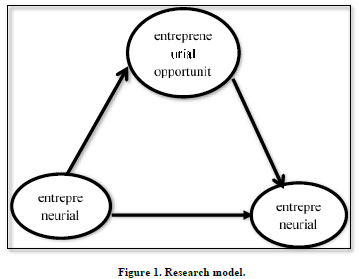
THEORETICAL REVIEW
The study is underpinned by the theory of Planned Behavior and further supported by Schumpeterian Theory and Kirzenian Theory in explaining the relationship among the variables.
Theory of Planned Behavior
In this study, the theory of planned behavior focuses on Ajzen’s, (1991) the theory of planned behavior (TPB) has three predictors of intention. These are attitude towards the behavior, subjective norms, and the degree of perceived behavior control (self-efficacy). He explained that attitude towards a behavior reflects the individual’s appraisal of the behavior, and the appraisal may be placed along a continuum running from favorable to unfavorable.
He indicates that the more favorable the appraisal the greater the intention. The subjective norms refer to the degree to which family, NGOs, friends, peers and society at large influence, expect or pressure the individual to perform the behavior in question. The TPB model suggests that the greater the expectation or pressure, the greater the gravitation towards the behavior.
Perceived behavioral control (self-efficacy) refers to the extent to which the individual feels Capable of performing the behavior. This is based on the individual’s know how and experience and his or her appraisal of likely obstacles to performing the behavior. The greater the feeling of behavioral control the stronger will be the intention to perform the behavior. However, (Ajzen, 1991) TPB suggest that attitude towards a behavior such as new venture creation predicts intentions, which in turn predict the actual behavior which is perceived social norms for going into business or venture creation.
Schumpeterian Theory
The creation theory involves more than just recognizing opportunities that already exist; it requires sensing the opportunity, then developing it and finally evaluating, and reframing the opportunity (O’Connor & Rice, 2001). In the Schumpeterian theory which is also known as the creation theory, the entrepreneurial opportunities are created rather than discovered; opportunities disrupt the existing system by innovative reconfiguration of resources (Shane, 2003). Entrepreneurial action is seen as making history since they are new, innovative and have a capacity to shift the economy instead of merely responding to it (Berglund, 2007). In this theory opportunities are shaped by the events, responses and performance of entrepreneurs; they usually look for ways to come up with new products or services by responding to consumers and market needs (Alvarez & Barney, 2007). The creation perspective is also promoted by Sarasvathy, (2001) who sees everyday activities by individuals or groups as a source of entrepreneurial opportunities. The creation theory is doubtful about the importance of the distinctions among entrepreneurs and non-entrepreneurs before recognition of an opportunity. In this theory opportunities only exist until they are created, therefore decision-making situation is indecisive (Alvarez & Barney, 2007).
Kirzenian Theory
In contrast to the Schumpeterian theory, Kirszner’s, (1997) in theory of entrepreneurial Alertness (also known as discovery theory) is about understanding how particular individuals make profits based on knowledge and information gaps that come about due to the differences in knowledge base among people in the market. Opportunities are assumed to come from external shocks that disrupt competitive equilibrium conditions. In this theory opportunities are seen as ever present and only need to be discovered by those entrepreneurs who are alert to them because they arise from market disequilibrium caused by faulty decision-making frameworks (Alvarez & Barney, 2007). According to the discovery theory, opportunities are seen as an objective phenomenon, independent of the actions of entrepreneur’s perception and just waiting to be revealed and exploited. Shane, (2003) mentions the changes that trigger discovery as “technological changes, political and regulatory changes, social and demographic changes” (p. 23). He argues that these types of events can discourage a competitive stability in the market thus forming opportunities.
According to Alvarez & Barney, (2007) the entrepreneur who recognizes opportunities is assumed to be much dissimilar from others because of their aptitude to see opportunities and exploit them. In the discovery theory, the entrepreneur’s decision to exploit an opportunity is considered to be dangerous; this is because the opportunities are seen as objective in nature. On the contrary, Alvarez & Barney, (2007) argue that the discovery theory is mainly focused on scouting for opportunities to produce new products or services within the entrepreneur’s environment. The discovery theory therefore involves both active and passive search in order to discover opportunities (Berglund, 2007).
EMPIRICAL REVIEW
This section is concerned with review of empirically related literature based on previous studies such as relationship between entrepreneurial alertness and entrepreneurial intention and the mediating role of entrepreneurial opportunity recognition.
Entrepreneurial Alertness and Entrepreneurial Intention
Study found that through cognitive perspective that the proximal constructs, including perceived behavioral controls (PBC) and attitudes have higher predictive values toward EI (Karimi, Biemans, Lans, Chizari, Mulder & Mahdei, 2013). It has been indicated that SN, PBC and favorable attitude toward behavior works together to enhance the intention of completing the behavior, that is known as PBC (Urban & Ratsimanetrimanana, 2015). According to Martin, McNally & Kay, (2013) the outcome of investment in human capital that is, knowledge and skills to identify the opportunity has a positive effect on entrepreneurial intention. Gelderen. Brand, Van Praag, Bodewes, Poutsma & Van Gils, (2008) study showed that entrepreneurial alertness has a significant impact on perceived behavioral control which is linked with individual entrepreneurial intention. Solesvik, Westhead, Matlay Harry and Parsyak, (2013) suggested that only the students of entrepreneurship courses/programs were having a higher entrepreneurial intention when they had built up a high level of entrepreneurial alertness specific human capital. The study of Hou, (2008) concluded that individual with strong entrepreneurial alertness more probable of identifying the opportunity which plays an important role developing individual actions to become an entrepreneur by starting a new venture. The results of this study showed that factors like environmental scanning, motivation, prior performance, a level of education, and capability affect the entrepreneurial alertness which led to entrepreneurial action.
Entrepreneurial Alertness and Entrepreneurial Opportunity Recognition
According to Kirzner, (1999) alertness has the potential to add substantial value to a business because alertness helps entrepreneurs to be aware of changes, shifts, opportunities and overlooked possibilities. For example, in an effort to establish nomological validity of the entrepreneurial alertness concept, Tang et al., (2012, p. 87) draw insights from the organizational innovation literature to contend that “alert entrepreneurs are likely to discover something new, and to increase innovations of their firms”. Roundy, Harrison, Khavul, Pérez-Nordtvedt & McGee, (2017) argue that entrepreneurial alertness can influence performance because alert entrepreneurs are instantaneous and nimble in their decision-making process, and are therefore more likely to lead their organization to earn first-mover advantages. McMullen and Shepherd, (2006) argue that alertness becomes an entrepreneurial behavior when alert individuals act upon identified opportunities. McMullen & Shepherd, (2006) further suggest that entrepreneurial alertness is likely to have a material impact on entrepreneurial performance provided entrepreneurs act to exploit identified opportunities ahead of others. Farsi, Arabiun and Moradi, (2012) concluded the opportunity recognition skills enhance significantly subjective norms which affect the entrepreneurial intentions. The role of entrepreneurial alertness for opportunity recognition has been recognized in the entrepreneurship research. However, the process of opportunity recognition and the decision for exploiting the opportunity are two different phases of the entrepreneurial process (McMullen & Shepherd 2006).
Entrepreneurial Opportunity Recognition and Entrepreneurial Intention
A case study by Rehman, (2011) on factors affecting opportunity recognition process found the following factors to have a significant influence namely, individual’s earlier work experience, their exchanges with customers, suppliers and other stakeholders. Entrepreneurial opportunity recognition ability could result in a motivating impact on the intention of individuals towards business start-ups as entrepreneurial career option (Van Gelderen, Brand, Van Praag, Bodewes, Poutsma, & Van Gils, 2008). Many entrepreneurship scholars have argued that opportunity recognition is important for any business venture Short, Ketchen, (Shook & Ireland, 2010). They argue that entrepreneurial opportunities are not always visible for all to see. Most scholars have termed opportunity as a first stage from where the other stages of new business enterprise develop (Short, 2010) for example argues that entrepreneurial actions and activities should be geared towards recognizing and exploiting opportunities.
Mediating Role of Entrepreneurial Opportunity Recognition
The creation theory involves more than just recognizing opportunities that already exist; it requires sensing the opportunity, then developing it and finally evaluating, and reframing the opportunity (O’Connor & Rice, 2001). In the Schumpeterian theory which is also known as the creation theory, the entrepreneurial opportunities are created rather than discovered; opportunities disrupt the existing system by innovative reconfiguration of resources (Shane, 2003). Entrepreneurial action is seen as making history since they are new, innovative and have a capacity to shift the economy instead of merely responding to it (Berglund, 2007).
RESEARCH GAP
Despite its potential, entrepreneurial alertness remains understudied due to measurement problems and limited understanding of its interplay with the environmental context (Edelman & Yli-Renko, 2010; McCaffrey, 2013; Tang et al., 2012). Empirical research on institutions and entrepreneurship in emerging markets and Africa in general, has not yet paid enough attention to how entrepreneurs can best recognize and evaluate opportunities available to them when scanning their unique environments (Welter & Smallbone, 2011). According to Baron (2007) despite opportunity recognition being seen as central to entrepreneurship, minimal efforts have been taken to examine it as a process thus ignoring the question of how opportunity recognition occurs. This also fails to address the question of the differences in the entrepreneur’s ability to recognize specific opportunities. Despite the numerous contributions in the literature on entrepreneurship, several authors point out that the discussion about the internal factors with the greatest impact on entrepreneurial intention is still open. Several studies demand this gap be filled (Arias, Restrepo & Restrepo, 2015). Furthermore, the mechanisms that link these individual factors to greater entrepreneurial intention are still not fully understood (Barba-Sánchez & Atienza-Sahuquillo, 2017). There is a gap, then, that encourages us to delve into how acquired and perceived skills of business undertaking can connect the personal traits of individuals with their entrepreneurial intention (Mueller, 2011). However, there is research intend to examine the role of entrepreneurial opportunity recognition in the relationship between entrepreneurial alertness and entrepreneurial intention among final year students of Plateau State University Bokkos and Polytechnic, Barkin Ladi.
SUMMARY OF LITERATURE REVIEW
Different concepts and variables were defined with scholars’ views reviewed. A research model was developed in the course of the study by the researcher in order to further explain entrepreneurial alertness which is a higher-order construct as independent variable, entrepreneurial opportunity recognition as the mediator while entrepreneurial intention as the dependent variable. The study also considers theories such as the theory of Planned Behavior, Schumpeterian Theory and Kirzenian Theory in explaining the relationships between the constructs.
METHODOLOGY
This study adopted cross-sectional research design. There are five essentials of research design: an activity and time-based plan, a plan based on the research question, a guide for selecting sources and types of information and procedural outline for every research activity (Cooper & Shindler, 2011). This study follows the positivist philosophical thought in research because the study favors deductive approach to knowledge, objective, quantifiable and generalizable. As Stated by Bryman and Bell (2011), positivism is about testing the theories and providing tools in order to develop laws. The study population comprised302 final year students such as 75 HND Accounting students while Plasu 91, 81 HND Business Administration students while Plasu 85 and 52 HND Mass Communication students while Plasu 65 (Field Survey, 2022).
UNIT OF ANALYSIS
The unit of analysis for this study is at the individual level because it deals with the students of Plateau State university Bokkos and Polytechnic as respondents. The sample size for this study is 217 final year students determined through the application of Krejcie and Morgan (1970) sample table such as 80 Accounting students, 80 Business Administration students, while 57 Mass Communication students. The sample size for each department stratum of staff is estimated using Bowley’s proportional statistical technique which is given below: (Table 1).
Where: nh: Number of units allocated to each stratum of staff; Nh: Number of staff in k2 each department stratum in the population; n: Sample size; N: The actual or total population under study, Thus,
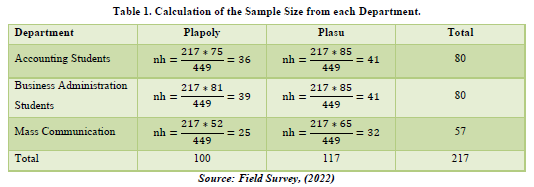
This study adopted simple random sampling. Simple random sampling is a probability random sampling technique where respondents have equal chances of being of being selected from the population. The reliability is determine using SMARTPLSv.4.4 a pilot survey test and result in Table 2 yielded composite reliability (CR) coefficient (r) = entrepreneurial alertness (ENA) is .924, entrepreneurial opportunity recognition (EOR) is .875 while entrepreneurial intention and (ENI) is .812. Based on the result of the research of Hair, Sarstedt, Ringle and Gudergan (2018), the CR values should be equal to or greater than 0.7 while Average variance extracted (AVE) should be higher than 0.5. According to Hair et al. (2013), the reliability value of an item particularly, for composite reliability, of 0.7 and more is acceptable, which is the case in the present study, indicating that all items could be considered acceptable. Table 3 also shows that the Average Variance Extracted (AVE) values for all the variables are found to be higher than 0.50 and since Hair et al. (2011) State that the values should be higher than 0.50 because if the AVE is less than 0.50 on average, more error remains in the items than the variance that is explained by the construct (Hair et al., 2013), therefore the values could be considered an acceptable convergent validity.
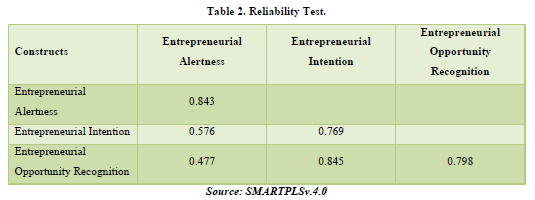
Validity is thus the degree to which results obtained from an analysis of the data actually represent the phenomenon under study (Mugenda & Mugenda, 2007). This study adopted composite validity. Face validity is the extent to which the measured variable appears to be an adequate measure, face validity is when the researcher inspects the questionnaire, face validity means if the designed instrument is apparently related to the construct underlying study while in content validity experts in the department of Business Administration will be employed to verify the authenticity of the questionnaires.
Pertaining to the Fornell-Larcker criterion for discriminant validity, the AVE for each indicator needs to be higher than the construct’s highest squared correlation with another construct and since all the constructs meet the criteria as observed in Table 3, there is no evidence of a lack of discriminant validity. Corresponding to Hair et al. (2013), the discriminant validity can be assessed by examining the cross loadings of the indicators. For the discriminant validity, a component is considered reliable when the value is higher than 0.7 and the construct loading is higher than its correlation coefficient.
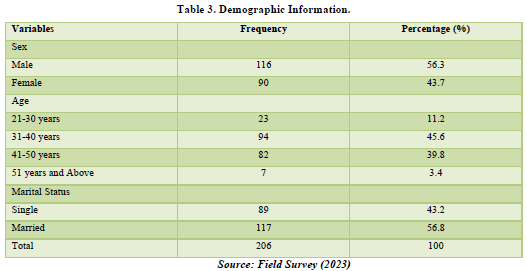
METHOD OF DATA ANALYSIS
According to Walliman (2011) data analysis is a process of gathering, modeling and transforming data with an aim of retrieving useful information, suggesting conclusions and supporting decision making. A Structure Equation Model (SEM) with SMART PLS (Partial least square regression) was utilized to test the formulated hypotheses. PLS-SEM is a covariance technique that evaluates the structured relationships between the observed and latent variables in the model and controls the measurement error while evaluating the relationship (Bagozzi & Yi, 2012, Gefen, Rigdon & Straub, 2011, Kline, 1998, Yuan & Bentlert, 1999). We implemented the two-step approach of Anderson and Gerbing (1988) for model analysis. First, we reviewed the measurement model by executing a confirmatory factor analysis and analyzing the validity and reliability of this study. We also scrutinized the adequacy of the model for the data observed. Secondly, we evaluated the conceptual framework by evaluating the standardized coefficients of the structural relationship and their significance and, then, validated the findings and test hypotheses, accordingly.
MODEL SPECIFICATION
The following model is developed to test to form a linear equation in coefficient table in chapter four.
Where: 
Y: Entrepreneurial Intention; β1 and β2: Beta coefficient of variable X which measure whether there is responsiveness of Y to changes in X; X1: Entrepreneurial Alertness; X2: Entrepreneurial Opportunity Recognition
DATA PRESENTION AND ANALYSIS
For the purpose of carrying out this study, Table 4 indicated that two hundred and seventeen (217) questionnaires were distributed to respondents. two hundred and six (206) questionnaires were returned while eleven (11) questionnaires were not returned.
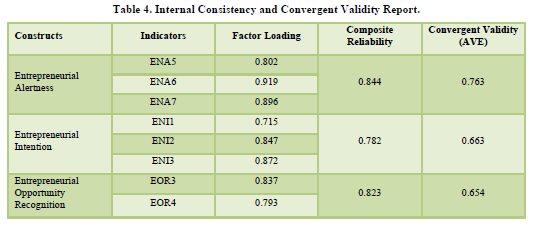
Table 3 showed that 116 (56.3%) of the respondents were male while 90 (43.7%) of the respondents were female. This means that majority of the respondents were male. Also indicated that 23 (11.2%) of the respondents were between the ages of 21-30, 94 (45.6%) were between the age of 31-40, 82 (39.8%) respondents were between the ages of 41-50 years while 7 (3.4%) respondents were between the ages of 51 years and above. This means that majority of the respondents were between the ages of 41-50 years. More so Table 3 revealed that 89 (43.2%) of the respondents were single while 117 (56.8%) of the respondents were postgraduate holders. This implies that majority of the respondents were married.
DATA ANALYSIS
In conducting data analysis through the use of partial least square-structural equation model (PLS-SEM) two major procedures are involved. First, the assessment of the measurement model to determine the relationship between constructs and their indicators also referred to as outer model (Hair, Ringle & Sarstedt, 2013). Second, structural assessment describes the relationship between latent variables in order to predict the expected outcome for hypothesis testing.
MEASUREMENT MODEL ASSESSMENT
This section discussed the measurement model process in this study. Measurement model in PLS-SEM is comprised of two types; Reflective and Formative model. According to Hair Jr (2013), reflective measurement model involves the assessment of internal consistency with emphasis on composite reliability, indicator reliability and convergent validity otherwise known as the Average Variance Extracted (AVE) and Discriminant validity. On the other hand, formative measurement model (Hair Jr et al., 2013), involves testing for convergent validity, collinearity of indicators, and testing the significance and relevance of the outer weights (Table 5).
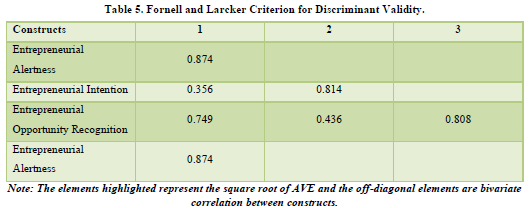
PLS SEM Version 4.0 Convergent Validity Assessment
As a requirement in reflective measurement model, all indicators of the same construct must possess this attribute. Convergent validity of a construct according to Hair, Black, Babin, and Anderson, (2014), is the extent to which an indicator correlates with other items within the same construct. This is determined by researchers through Average Variance Extracted (AVE) in reflective indicators. Hair et al. (2011: 2014) posits that an AVE value of equal or greater than 0.5 is considered adequate determinant of constructs convergent validity. This substantiates their earlier claim of a threshold internal consistency 0.708 which when squared will give AVE of at least 0.5. Therefore, beside the AVE result produced in PLS-SEM measurement model, the reliability coefficient is another way to determine construct measurement strength. Consequently, Table 5 showed the average variance extracted (AVE) of all the constructs being measured in this model scored AVE above the threshold of 0.5 indicating a high convergent validity.
Discriminant Validity Assessment
Another way to determine the suitability of a measurement model before furthering with any analysis is to ensure that discriminant validity exists between the indicators of different constructs. Discriminant validity as the name implies, is conducted to establish that a construct as used in a given study is dissimilar to other constructs (Henseler, Ringle & Sarstedt, 2014) within the same framework. Two methods have been widely used by researchers over the years in determining constructs discriminant validity which include, cross loading, Fornell and Larcker and Heterotrait and Monotrait (HTMT) criterion. The Fornell and Larcker criterion is used for this study.
Fornell and Larcker criterion for Discriminant validity
Fornell and Larcker criteria of discriminant validity. The technique establishes discriminant validity among constructs at a point where the squared AVE is higher than the correlation with other constructs. Results as presented in the Table 5 revealed that discriminant validity is established, since the squared of the AVEs as highlighted in the diagonal is greater than correlations within the row as the column.
Assessing Formative Measurement Model
According to Hair, (2014) indicators loading must be at least 0.7. Figure 2 showed he retained indicators of the four dimensions of construct of talent management. Researchers have disagreed on the replication of reflective measurement indices in the formative construct. Typical here the outright exclusion of reliability analysis as meaningless informative construct (Hulland &Business, 1999), arguing that two variable that are negatively correlated might serve as a meaningful indicator for a construct (Diamantopoulus, Riefler & Roth, 2008).
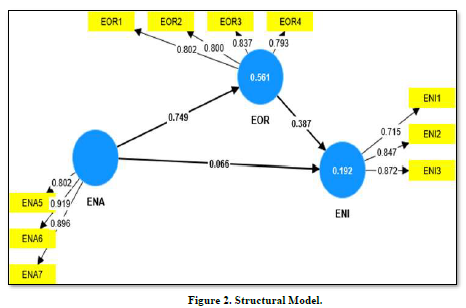
ASSESSING STRUCTURAL MODEL FOR COLLINEARITY
There is no multicollinearity in the data analysis of statistics showed that this assumption has been met as, VIF scores in Table 6 were well below 3.3 (1.5, 3.542, 3.277, 1.285, 1.929, 1.757, 1.791, 1.741, 2.022 and 1.772) for ENA5, ENA6, ENA7, ENI1, ENI2, ENI3, EOR1, EOR2, EOR3and EOR4respectively. The VIF (Variance Inflation Factor) in coefficient table 9 showed the level of collinearity between IVs. This means the IVs are ≤ 5.0 (O’Brien, 2007).
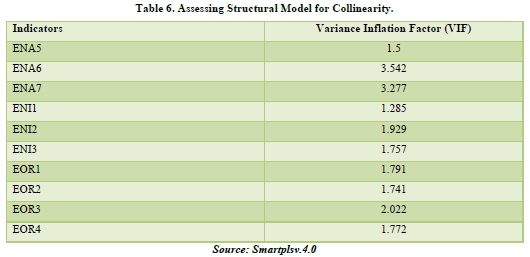
Hypotheses testing
In assessing the path coefficient, various relationships that were hypothesized earlier are tested to establish the nature of the relationships as well as its significance.
- HO1: There is no significant relationship between entrepreneurial alertness and entrepreneurial intention of Plateau State University Bokkos and Polytechnic students.
- HO2: There is no significant relationship between entrepreneurial alertness and entrepreneurial opportunity recognition of Plateau State University Bokkos and Polytechnic students.
- HO3: There is no significant relationship between entrepreneurial opportunity recognition and entrepreneurial intention of Plateau State University Bokkos and Polytechnic students.
- HO4: Entrepreneurial opportunity recognition does not mediate the relationship between entrepreneurial alertness and entrepreneurial intention of Plateau State University Bokkos and Polytechnic students.
Assessing Path Coefficient and Hypotheses Testing
In order to assess the path coefficient in line with the hypotheses postulated in this study, a bootstrapping command was carried out using SMARTPLS v.4.0and the results displayed the path coefficient or the direct effect, t-statistic and the p-value in Table 7. Based on the direct effect on two tail-tests at 95% level significance as postulated in the hypotheses, H1, H2 and H3 showed that relationships were indeed in the expected direction while H4 revealed that relationships were indirect effect. However, p-value revealed the entire four hypotheses (HO1, HO2, HO3 and HO4) were supplied. The direct effect of entrepreneurial alertness on entrepreneurial intention showed no predictive significant relationship because 0 falls between lower class limit (LCL) of -0.11 and upper class limit (UCL) of 0.28, entrepreneurial alertness showed a significant effect on entrepreneurial opportunity recognition 0 falls between lower class limit (LCL) of 0.674 and upper class limit (UCL) of 0.861 while entrepreneurial opportunity recognition had a significant effect on entrepreneurial intention because 0 falls between lower class limit (LCL) of 0.161 and upper class limit (UCL) of 0.577.

Table 8 showed a significant effect of mediation of entrepreneurial opportunity recognition, 0 falls between lower class limit (LCL) of 0.124 and upper-class limit (UCL) of 0.442. This means that entrepreneurial opportunity recognition mediated the relationship between entrepreneurial alertness and entrepreneurial intention.

Assessing coefficient of determination (r2)
Smartpls v.4.0
This is referred to as models’ predictive accuracy denoted by an R2 value. Hair, (2014) posits that coefficient of determination measures the effect of exogenous talent variable on endogenous talent variable. According to Cohen (1988) R2 values of 0.02, 0.13, and 0.26 are considered weak, moderate and substantial respectively. Falk and Miller (1992) suggested a minimum of 10% as acceptable for a variance explained to be regarded as adequate. In line with the aforementioned, the study considered the R2of one endogenous variable obtained from PLS algorithm as presented in Table 9. The results revealed that, 19.2% variance in entrepreneurial intention is explained by entrepreneurial alertness and entrepreneurial opportunity recognition while 56.1% variance in entrepreneurial opportunity recognition is explained by entrepreneurial alertness. This means the variance substantial.

Assessing effect size f2
SMARTPLSv.4.0
One of the uniqueness of SMARTPLSv.4.0is the simplified way of determining the effect size of an exogenous construct on endogenous construct in a structural model, it is not enough to say that a construct or group of constructs have substantial, moderate or weak coefficient of determination, but the need to know the effect size of each exogenous construct is critical to provide such information. Effect size f2 analysis appropriate amount of influence construct contributes in a structural relationship. Hair (2014) provided a yardstick of assessing effect size f2 of a construct as;
- 35 as large effect size
- 15 as medium effect size
- 02 as small effect size
In line with the above guideline an f2 was conducted using SMARTPLSv.4.0as the result presented in Table 10.

DISCUSSION OF FINDINGS
The Relationship between Entrepreneurial Alertness and Entrepreneurial Intention of Plateau State University Bokkos and Polytechnic Students
The study findings of the study revealed that there is no significant relationship between entrepreneurial alertness and entrepreneurial intention of Plateau State University Bokkos and Polytechnic students. This contrast with the study conducted. Study found that through cognitive perspective that the proximal constructs, including perceived behavioral controls (PBC) and attitudes have higher predictive values toward EI (Karimi, Biemans, Lans, Chizari, Mulder & Mahdei, 2013). It has been indicated that SN, PBC and favorable attitude toward behaviour works together to enhance the intention of completing the behavior, that is known as PBC (Urban & Ratsimanetrimanana, 2015).
The Relationship between entrepreneurial alertness and entrepreneurial opportunity recognition of Plateau State University Bokkos and Polytechnic students
The study findings of the study showed that there is a significant relationship between entrepreneurial alertness and entrepreneurial opportunity recognition of Plateau State University Bokkos and Polytechnic students. This agreed with the study conducted. Roundy, Harrison, Khavul, Pérez-Nordtvedt and McGee (2017) argue that entrepreneurial alertness can influence performance because alert entrepreneurs are instantaneous and nimble in their decision-making process, and are therefore more likely to lead their organization to earn first-mover advantages. McMullen and Shepherd (2006) argue that alertness becomes an entrepreneurial behavior when alert individuals act upon identified opportunities.
The Relationship between entrepreneurial opportunity recognition and entrepreneurial intention Plateau State University Bokkos and Polytechnic students
The study findings of the study showed that there is a significant relationship between entrepreneurial opportunity recognition and entrepreneurial intention of Plateau State University Bokkos and Polytechnic students. This agreed with the study conducted. A case study by Rehman et al., (2011) on factors affecting opportunity recognition process found the following factors to have a significant influence namely, individual’s earlier work experience, their exchanges with customers, suppliers and other stakeholders.
The role of entrepreneurial opportunity recognition in the Relationship between entrepreneurial alertness and entrepreneurial intention of Plateau State University Bokkos and Polytechnic students
The study findings of the study showed that entrepreneurial opportunity recognition mediated the relationship between entrepreneurial alertness and entrepreneurial intention of Plateau State University Bokkos and Polytechnic students. This agreed with the study conducted. The creation theory involves more than just recognizing opportunities that already exist; it requires sensing the opportunity, then developing it and finally evaluating, and reframing the opportunity (O‟Connor & Rice, 2001). In the Schumpeterian theory which is also known as the creation theory, the entrepreneurial opportunities are created rather than discovered; opportunities disrupt the existing system by innovative reconfiguration of resources (Shane, 2003).
SUMMARY, CONCLUSION AND RECOMMENDATIONS
Summary of findings
The study showed that entrepreneurial alertness had no significant effect on entrepreneurial intention. The study also revealed that entrepreneurial alertness had a significant effect on entrepreneurial opportunity recognition. The study further revealed that entrepreneurial opportunity recognition had a significant effect on entrepreneurial intention. More so, the study showed that entrepreneurial opportunity recognition had a significant effect entrepreneurial alertness and entrepreneurial intention.
CONCLUSION
Firstly, on the relationship between entrepreneurial alertness and entrepreneurial intention of Plateau State University Bokkos and Polytechnic students, the findings of this study came to conclusion that entrepreneurial alertness does not lead to increase in entrepreneurial intention. Secondly, on the relationship between entrepreneurial alertness and entrepreneurial opportunity recognition of Plateau State University Bokkos and Polytechnic students. The findings of this study concluded that entrepreneurial alertness led to increase in entrepreneurial opportunity recognition. In view of the third specific objective, the study also concluded that entrepreneurial opportunity recognition led to increase in entrepreneurial intention of Plateau State University Bokkos and Polytechnic students. Lastly, the study in view of the fourth specific objective which is the role of entrepreneurial opportunity recognition in the relationship between entrepreneurial alertness and entrepreneurial intention, the study concluded that entrepreneurial opportunity recognition mediated the relationship between entrepreneurial alertness and entrepreneurial intention of Plateau State University Bokkos and Polytechnic students.
RECOMMENDATIONS
The following recommendations are made:
- Management of University Bokkos and Polytechnic should add entrepreneurial self-efficacy to their various entrepreneurial programs encompassing design-thinking workshops, pitch-meeting simulations, elevator talks, creativity workshops, and brain-storming.
- Management of University Bokkos and Polytechnic should have the ability to generate good ideas and change it into an entrepreneurial concept or to enhance an existing venture that contributes to customer/societal value and produces entrepreneurial revenues.
- Management of University Bokkos and Polytechnic should be entrepreneurially alert and to have greater capability to recognize possible opportunities for profit than others.



